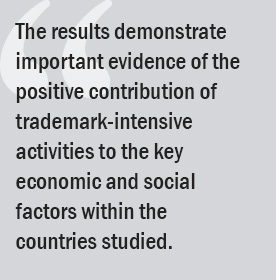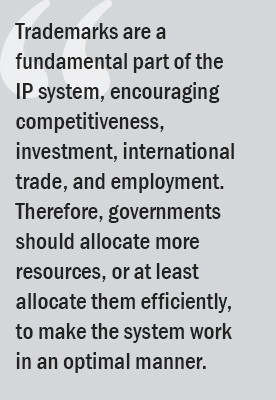Uncategorized
INTA’s José Luis Londoño Details New Study on the Economic Value of Trademarks in Latin America
Published: November 1, 2019
 INTA has released a new study that highlights the important contribution that trademark-intensive industries make to countries in the Latin America and Caribbean (LAC) region. The report, titled Trademarks in Latin America: Economic Impact in 10 Latin America and Caribbean Countries (Argentina, Brazil, Colombia, Costa Rica, Chile, the Dominican Republic, Guatemala, Mexico, Panama, and Peru), expands on Trademarks in Latin America: A study of their economic impact in five countries in the region (Chile, Colombia, Mexico, Panama and Peru), which was published in 2016.
INTA has released a new study that highlights the important contribution that trademark-intensive industries make to countries in the Latin America and Caribbean (LAC) region. The report, titled Trademarks in Latin America: Economic Impact in 10 Latin America and Caribbean Countries (Argentina, Brazil, Colombia, Costa Rica, Chile, the Dominican Republic, Guatemala, Mexico, Panama, and Peru), expands on Trademarks in Latin America: A study of their economic impact in five countries in the region (Chile, Colombia, Mexico, Panama and Peru), which was published in 2016.
Among the key findings, the study results revealed that each of the 10 countries studied contained between 13 and 21 trademark-intensive sectors out of possible total of 45. Costa Rica had the most trademark-intensive sectors, while Guatemala had the least among the countries studied. (For a detailed breakdown of the trademark-intensive sectors by country, see the full report here.)
Below, INTA Chief Representative Officer, Latin America and the Caribbean Office José Luis Londoño discusses the findings of the study, and what they show about the impact of trademarks in the LAC region.
What makes the 2016 and 2018 studies relevant to the global trademark community?
The 2016 study was the first of its kind within the LAC region to demonstrate the importance of trademark-intensive sectors to economic activity, employment, and international trade. While several studies had previously shown significant findings related to the vital role intellectual property (IP) rights play in economic growth, the contribution of trademarks specifically, as distinct from other forms of IP, had not been as fully examined in the LAC region.
In 2018, INTA and the Inter-American Association of Intellectual Property (ASIPI) expanded upon the 2016 study to: (1) update findings for the five countries first studied; (2) gather findings for five additional countries, namely Argentina, Brazil, Costa Rica, the Dominican Republic, and Guatemala; and (3) provide more significant insights to legislators, entrepreneurs, media, and consumers at large on the substantial economic contributions that trademarks bring to society.
What makes these 10 countries particularly important?
All of the 10 countries highlighted in the study were chosen because they account for nearly 90 percent of the LAC region’s combined gross domestic product (GDP), and each of the countries studied has differing levels of trademark activity. The results demonstrate important evidence of the positive contribution of trademark-intensive activities to the key economic and social factors within the countries studied.
What were some of the key findings of the new study? How did these findings compare with similar research regarding Europe and the United States?
The results for Guatemala actually demonstrate the value of trademark-intensive activities for an economy, because, while it had the lowest number of trademark-intensive sectors, these trademark sectors contributed to a greater-than-expected degree to the country’s GDP. In Guatemala, trademark-intensive sectors contribute 34 percent to the country’s GDP, which equates to US $25.7 billion, according to the report. That percentage of contribution is the second highest, behind Costa Rica (42%), and is well above the 22 percent average in the region.
Another key finding was that pharmaceutical products and cleaning and cosmetic products were found to be among the most trademark-intensive sectors across all 10 countries. Clothing and footwear, food products, and communications and entertainment also feature prominently.
In the 10 countries studied, the report found that trademark-intensive sectors:
- Contribute US $766.6 billion (22% average) to the total GDP of these countries;
- Employ 35 million workers (18% average) of the total workforce, which is larger than the size of the population of Peru. So, for every six jobs, one is from a trademark-intensive sector.
- Pay up to 57 percent more than nontrademark-intensive sectors; and
- Contribute 31 percent of exports and 34 percent of imports, on average.
Importantly, the study found that trademark-intensive industries in the LAC countries studied are significant contributors to GDP, employment, wage premium, and international trade. However, the contributions by LAC countries to these economic factors are at a lower level compared to the United States and Europe.
It’s also important to note that this difference in European and U.S. numbers may be attributed to two main factors: (1) the current primary economic drivers of LAC countries studied are agriculture, mining, exports of related commodities, and basic manufacturing. These industries are typically not trademark-intensive, and therefore their significant contributions to the economies of the LAC countries studied are not reflected. (2) The high percentage of informal economies in the LAC countries studied account for approximately 53 percent of the workforce. (As defined by the International Labour Organization, informal employment usually means a low-quality job without worker protections, such as Social Security or overtime compensation, and is prevalent in informal economies.)
 What are some of the country-specific findings that you found interesting?
What are some of the country-specific findings that you found interesting?
One finding that stands out is that Costa Rica has a 57 percent wage premium, marking the highest among the 10 countries and surpassing the U.S. and European averages in this category. A closer examination of results from Costa Rica also indicates the contributions of trademark-intensive sectors to GDP is at 42 percent, the highest among all the countries studied. Not surprisingly, among all 10 countries studied, Costa Rica has the highest number of trademark-intensive sectors (21 out of the 45 sectors studied).
How can the study be used to the benefit of policy makers and consumers in the region?
The survey results have many possible uses. For instance, the study can serve as a valuable reference point for policy makers as they work to strengthen their IP policies and strategies.
In addition, the results demonstrate that piracy and counterfeits are not minor crimes; they have consequences on the economy and therefore stronger actions should be taken in the region to fight these problems.
Likewise, this study shows that trademarks are important contributors to other significant social and economic factors. For example, if trademark-intensive activities contribute positively to employment, employees in turn contribute to their respective countries’ fiscal income in terms of public services and health care. Therefore, attacking trademarks with restrictive regulations could affect employment and the fiscal income, which could lead to a lack of resources to cover the social services.
Finally, but very important as well, this study should once and for all be sufficient to prove that trademarks are not just a matter of registration proceedings. They are a fundamental part of the IP system that encourages competitiveness, investment, international trade, and employment. Therefore, governments should allocate more resources, or at least allocate them efficiently, to make the system work in an optimal manner.
What does it take to produce a study such as this?
This initiative was an ambitious one for INTA and ASIPI. We have already had some experience conducting several studies in the region. As with the last impact study in Latin America, we partnered with ASIPI and commissioned Fundación de Investigaciones Económicas Latinoamericanas to conduct the study. ASIPI and INTA each had Project Teams that reviewed the drafts and contributed to the study process. ASIPI’s Project Team was led by Juan Berton Moreno (Berton Moreno + Ojam, Argentina), and INTA’s Project Team was led by Impact Studies Committee member Lucia Scarpati (Berken IP, Argentina). None of this would have been possible without the support of our Project Team leaders and members.
Although every effort has been made to verify the accuracy of items in the INTA Bulletin, readers are urged to check independently on matters of specific concern or interest.
© 2019 International Trademark Association